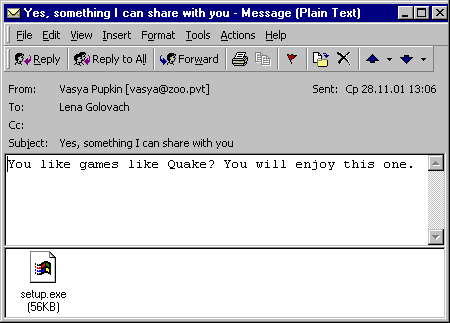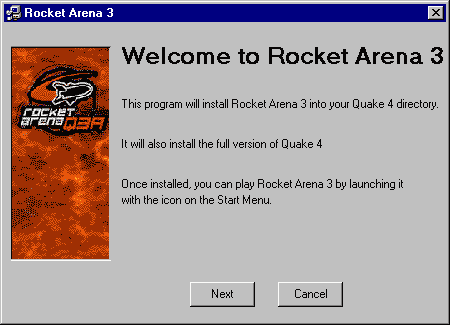Parent class: VirWare
Viruses and worms are malicious programs that self-replicate on computers or via computer networks without the user being aware; each subsequent copy of such malicious programs is also able to self-replicate. Malicious programs which spread via networks or infect remote machines when commanded to do so by the “owner” (e.g. Backdoors) or programs that create multiple copies that are unable to self-replicate are not part of the Viruses and Worms subclass. The main characteristic used to determine whether or not a program is classified as a separate behaviour within the Viruses and Worms subclass is how the program propagates (i.e. how the malicious program spreads copies of itself via local or network resources.) Most known worms are spread as files sent as email attachments, via a link to a web or FTP resource, via a link sent in an ICQ or IRC message, via P2P file sharing networks etc. Some worms spread as network packets; these directly penetrate the computer memory, and the worm code is then activated. Worms use the following techniques to penetrate remote computers and launch copies of themselves: social engineering (for example, an email message suggesting the user opens an attached file), exploiting network configuration errors (such as copying to a fully accessible disk), and exploiting loopholes in operating system and application security. Viruses can be divided in accordance with the method used to infect a computer:- file viruses
- boot sector viruses
- macro viruses
- script viruses
Class: Email-Worm
Email-Worms spread via email. The worm sends a copy of itself as an attachment to an email message or a link to its file on a network resource (e.g. a URL to an infected file on a compromised website or a hacker-owned website). In the first case, the worm code activates when the infected attachment is opened (launched). In the second case, the code is activated when the link to the infected file is opened. In both case, the result is the same: the worm code is activated. Email-Worms use a range of methods to send infected emails. The most common are: using a direct connection to a SMTP server using the email directory built into the worm’s code using MS Outlook services using Windows MAPI functions. Email-Worms use a number of different sources to find email addresses to which infected emails will be sent: the address book in MS Outlook a WAB address database .txt files stored on the hard drive: the worm can identify which strings in text files are email addresses emails in the inbox (some Email-Worms even “reply” to emails found in the inbox) Many Email-Worms use more than one of the sources listed above. There are also other sources of email addresses, such as address books associated with web-based email services.Read more
Platform: Win32
Win32 is an API on Windows NT-based operating systems (Windows XP, Windows 7, etc.) that supports execution of 32-bit applications. One of the most widespread programming platforms in the world.Description
Technical Details
This is a virus-worm that spreads via the Internet attached to infected e-mails. The worm itself is a Windows PE EXE file about 57Kb in length, and it is written in Visual Basic Script.
The infected messages contain differing subjects, bodies and attached-file names that are randomly selected from the following variants:
Subjects:Something very specialBodies (one-line texts):
I know you will like this
Yes, something I can share with you
Wait till you see this!
A brand new game! I hope you enjoy it
Hey you, take a look at the attached file. You won't believe your eyes when you open it!as well as (multiline texts):
You like games like Quake? You will enjoy this one.
Did you see the pictures of me and my battery operated boyfriend?
My best friend,Attached file:
This is something you have to see!
Till next time
Is Internet that safe?
Check it out

Infected file run
The worm activates from an infected e-mail only when a user clicks on the attached file, displaying the following:

At the same time, the worm installs itself to the system. In the event that the [Next] button is pressed, nothing happens (except installation of the worm's copies to the system), and the worm's application simply terminates. When the [Cancel] button is pressed, the worm starts its e-mail spreading routine.
Installing
While installing into the system, the worm creates the new directory C:EIRAM, and copies itself using the following names:
c:eiramquake4demo.exe
f:quake4demo.exe (if this drive exists)
and then registers these files in the Registry auto-run keys:
HKEY_CURRENT_USERSOFTWAREMicrosoftWindowsCurrentVersionRun
"quake"="c:eiramquake4demo.exe"
"Q4"="f:quake4demo.exe" HKEY_LOCAL_MACHINESoftwareMicrosoftWindowsCurrentVersionRun
"Q4"="c:\eiramquake4demo.exe"
"quake"="f:quake4demo.exe"
Later, while sending e-mail messages, the worm also may create more of its copies in the Windows directory:
honey.exe
quake4demo.exe
setup.exe
Spreading
The e-mail spreading routine is activated only when a user presses the [Cancel] button in the message box (see above).
To send infected messages, the worm uses MS Outlook, and sends messages to all addresses found in the Outlook address book.
Payload
Upon each start, the worm activates its payload routine, which searches for the following files: *.exe, *.xls, *.doc, *.mdb, *.htm, *.html, *.txt, *.ocx and overwrites them with the following text:
You've didn't protected your files well enough
Let this be a lesson! Never trust someone else
eiram 1999-2001
Read more
Find out the statistics of the vulnerabilities spreading in your region on statistics.securelist.com